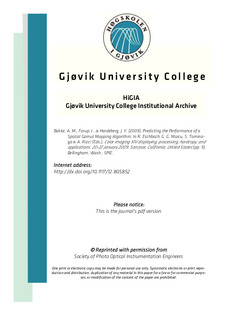| dc.contributor.author | Bakke, Arne Magnus | |
| dc.contributor.author | Farup, Ivar | |
| dc.contributor.author | Hardeberg, Jon Yngve | |
| dc.date.accessioned | 2011-05-04T08:17:07Z | |
| dc.date.available | 2011-05-04T08:17:07Z | |
| dc.date.issued | 2009 | |
| dc.identifier.citation | Bakke, A. M., Farup, I., & Hardeberg, J. Y. (2009). Predicting the Performance of a Spatial Gamut Mapping Algorithm. In R. Eschbach, G. G. Marcu, S. Tominaga & A. Rizzi (Eds.), Color imaging XIV displaying, processing, hardcopy, and applications: 20-22 January 2009, San Jose, California, United States (pp. 9). Bellingham, Wash.: SPIE. | en_US |
| dc.identifier.isbn | 9780819474919 | en_US |
| dc.identifier.issn | 0277-786X | |
| dc.identifier.uri | http://hdl.handle.net/11250/142494 | |
| dc.description | This is the copy of journal's version originally published in Proc. SPIE 7241. Reprinted with permission of SPIE: http://spie.org/x10.xml?WT.svl=tn7 | en_US |
| dc.description.abstract | Gamut mapping algorithms are currently being developed to take advantage of the spatial information in an image to improve the utilization of the destination gamut. These algorithms try to preserve the spatial informa- tion between neighboring pixels in the image, such as edges and gradients, without sacrificing global contrast. Experiments have shown that such algorithms can result in significantly improved reproduction of some images compared with non-spatial methods. However, due to the spatial processing of images, they introduce unwanted artifacts when used on certain types of images. In this paper we perform basic image analysis to predict whether a spatial algorithm is likely to perform better or worse than a good, non-spatial algorithm. Our approach starts by detecting the relative amount of areas in the image that are made up of uniformly colored pixels, as well as the amount of areas that contain details in out-of-gamut areas. A weighted difference is computed from these numbers, and we show that the result has a high correlation with the observed performance of the spatial algorithm in a previously conducted psychophysical experiment. | en_US |
| dc.language.iso | eng | en_US |
| dc.publisher | Society of Photo Optical Instrumentation Engineers (SPIE) | en_US |
| dc.relation.ispartofseries | Proceedings of SPIE;7241 | |
| dc.title | Predicting the Performance of a Spatial Gamut Mapping Algorithm | en_US |
| dc.type | Journal article | en_US |
| dc.type | Peer reviewed | en_US |
| dc.subject.nsi | VDP::Mathematics and natural science: 400::Information and communication science: 420::Simulation, visualization, signal processing, image processing: 429 | en_US |
| dc.source.pagenumber | 9 s. | en_US |
| dc.identifier.doi | http://dx.doi.org/10.1117/12.805852 | en_US |
